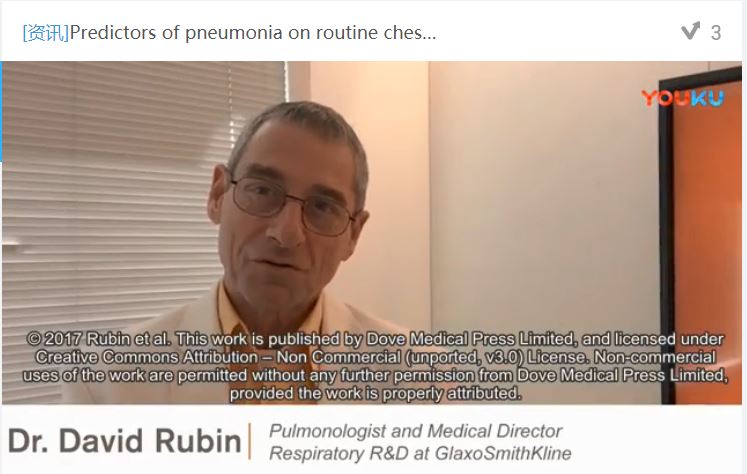108605
论文已发表
注册即可获取德孚的最新动态
IF 收录期刊
- 3.4 Breast Cancer (Dove Med Press)
- 3.2 Clin Epidemiol
- 2.6 Cancer Manag Res
- 2.9 Infect Drug Resist
- 3.7 Clin Interv Aging
- 5.1 Drug Des Dev Ther
- 3.1 Int J Chronic Obstr
- 6.6 Int J Nanomed
- 2.6 Int J Women's Health
- 2.9 Neuropsych Dis Treat
- 2.8 OncoTargets Ther
- 2.0 Patient Prefer Adher
- 2.2 Ther Clin Risk Manag
- 2.5 J Pain Res
- 3.0 Diabet Metab Synd Ob
- 3.2 Psychol Res Behav Ma
- 3.4 Nat Sci Sleep
- 1.8 Pharmgenomics Pers Med
- 2.0 Risk Manag Healthc Policy
- 4.1 J Inflamm Res
- 2.0 Int J Gen Med
- 3.4 J Hepatocell Carcinoma
- 3.0 J Asthma Allergy
- 2.2 Clin Cosmet Investig Dermatol
- 2.4 J Multidiscip Healthc

Predictors of pneumonia on routine chest radiographs in patients with COPD: a post hoc analysis of two 1-year randomized controlled trials
Authors Rubin DB, Ahmad HA, O'Neal M, Bennett S, Lettis S, Galkin DV, Crim C
Received 24 May 2017
Accepted for publication 25 August 2017
Published 8 January 2018 Volume 2018:13 Pages 189—201
DOI https://doi.org/10.2147/COPD.S142530
Checked for plagiarism Yes
Review by Single-blind
Peer reviewers approved by Dr Charles Downs
Peer reviewer comments 3
Editor who approved publication: Dr Richard Russell
Background: Patients with COPD are at risk for life-threatening pneumonia.
Although anatomical abnormalities in the thorax may predispose to pneumonia,
those abnormalities identified on routine chest X-rays (CXRs) in patients with
COPD have not been studied to better understand pneumonia risk.
Methods: We conducted a post hoc exploratory analysis of
data from two replicate year-long clinical trials assessing the impact of
fluticasone furoate–vilanterol versus vilanterol alone on COPD exacerbations
(GSK studies: HZC102871/NCT01009463 and HZC102970/NCT01017952). Abnormalities
on baseline CXRs from 179 patients who developed pneumonia and 50 randomly
selected patients who did not were identified by blinded consensus readings
conducted by two radiologists. Positive and negative likelihood ratios and
diagnostic odds ratios (ORs) were calculated to evaluate the markers for
subsequent pneumonia development during the 1-year study period.
Results: Baseline characteristics distinguishing the pneumonia
and non-pneumonia groups included a lower body mass index (24.9 vs
27.5 kg/m2, P =0.008), more severe airflow
obstruction (mean post-bronchodilator forced expiratory volume in 1 second [FEV1]/forced vital capacity ratio: 42.3% vs 47.6%, P =0.003), and prior pneumonia (36%
vs 20%, P =0.030). Baseline CXR
findings with the highest diagnostic ORs were: elevated hemi-diaphragm (OR:
6.87; 95% CI: 0.90, 52.26), thick tracheal-esophageal stripe (OR: 4.39 [0.25,
78.22]), narrow cardiac silhouette (OR: 2.91 [0.85, 9.99]), calcified pleural
plaque/mid-chest pleural thickening (OR: 2.82 [0.15, 53.76]), and
large/prominent pulmonary artery shadow (OR: 1.94 [0.95, 3.97]). The presence
of a narrow cardiac silhouette at baseline was associated with a statistically
significant lower mean pre-bronchodilator FEV1 (P =0.040). There was also a trend
for a lower mean pre-bronchodilator FEV1 in patients
with a large/prominent pulmonary artery shadow at baseline (P =0.095).
Conclusion: Findings
on routine CXR that relate to pathophysiological mechanisms of pneumonia could
help determine pneumonia risk in patients with COPD.
Keywords: COPD,
pneumonia, chest X-rays, predictors of risk
摘要视频链接:Predictors of pneumonia on
routine chest radiographs in patients with COPD
